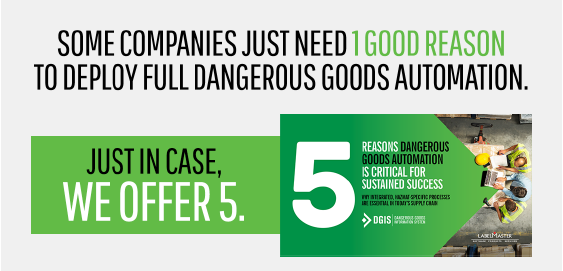

Week of June 13th, 2022
Linking supply chain news with dangerous goods compliance
Achieving greater supply chain visibility has been a focus across the industry for years. In the face of growing disruptions, material shortages, shipping costs and customer demands, businesses must take an even closer look into the specific areas of the supply chain where better visibility is needed to be successful.
Let’s examine some recent industry news.
SUPPLY CHAIN NEWS
- Improving Supply-Chain Visibility a Top Priority for Manufacturers, Survey Says: An overwhelming 88% of manufacturers want to thin their supplier pool, according to a Fictiv survey.
- Supply Chain Execs Need to be Flexible, Visibility into World Events: Supply chain executives need real-time visibility into what’s happening in the world and to be flexible amid global issues.
- Gartner 2022 Magic Quadrant for Real-Time Transportation Visibility Platforms: What’s Changed?: Gartner’s 2022 Magic Quadrant for Real-Time Transportation Visibility Platforms offers an independent window into the state of play as it regards the movers and shakers in the supply chain visibility market.
- Port Congestion Shines Light on Visibility Gaps: Despite recent industry buzz surrounding supply chain visibility and transparency, adoption of visibility solutions for ocean shipping is lagging across the industry.
- The Two Types of Visibility That Boost Supply Chain Resilience: Research from Accenture found that companies with greater visibility are better positioned to handle all kinds of disruptions, creating a more resilient supply chain.
OUR PERSPECTIVE
- Visibility is key when it comes to compliance. Supply chain visibility isn’t just tracking shipments in real-time or having a comprehensive view of your logistics network. For DG shippers, true visibility means knowing what exactly you’re shipping, the rules and regulations for shipping those goods, which of your facilities have the personnel, processes and systems to ship DG compliantly, and whether or not your shipments are compliant across the supply chain.
- Better visibility requires better data. Achieving better visibility across the DG supply chain starts with having better data. Ensure you have complete and accurate product and shipping data, including components, makeup, dimensions, quantities, origins, shipping mode, etc. Then look to better absorb data into your supply chain – from suppliers and logistics providers to other departments. Don’t just assume everyone has access to this information or knows how to handle DG shipments, even if they have warehousing or shipping software in place.
- Understand how your visibility efforts impact compliance. Many temperature monitoring or location tracking devices used to provide greater visibility run on lithium batteries, which are classified as DG and have their own transport regulations. Ensuring that hazmat shipments are fully compliant requires that both the products being shipped and what those items are shipped with (e.g., data logger containing a lithium battery, etc.) comply with regulations of both the origin and destination countries.
Add your voice to the 7th Annual DG Global Confidence Outlook!
Take a couple minutes to answer a few questions on how your organization has navigated the supply chain challenges and the areas of your compliance operations that you need help addressing. Your responses are anonymous, and we’ll share the results later this year.
To learn more about Dangerous Goods software or how to establish a safer, more compliant supply chain, visit https://www.labelmaster.com.
Have questions about Dangerous Goods transport? Call the Labelmaster Regulatory Hotline at 1.800.621.5808.
Automation is the key to handling today’s supply chain challenges. But without true Dangerous Goods automation, you may be operating at a competitive disadvantage.
Integrating Labelmaster’s DGIS with your existing TMS, ERP, WMS or OMS platforms puts Dangerous Goods information in the same window as all your other shipping information. Hazmat shipments become as simple as non-regulated shipments—a seamless part of your normal workflows.
Our new eBook explains how integrating DGIS with your existing automation platforms can help your organization sustain success in today’s supply chain.




